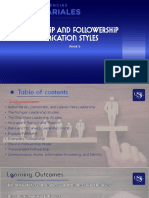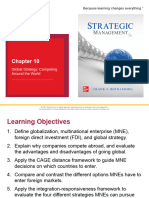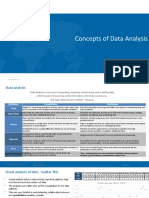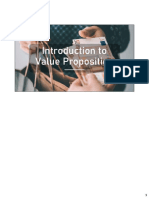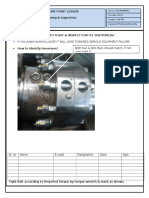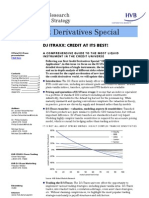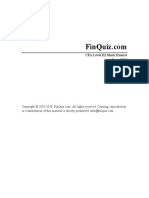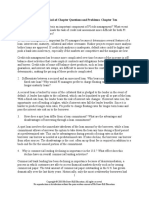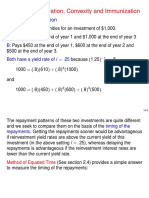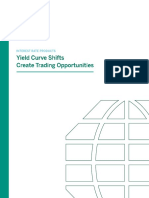Market Risk
Market Risk
Uploaded by
mmkattaCopyright:
Available Formats
Market Risk
Market Risk
Uploaded by
mmkattaOriginal Description:
Copyright
Available Formats
Share this document
Did you find this document useful?
Is this content inappropriate?
Copyright:
Available Formats
Market Risk
Market Risk
Uploaded by
mmkattaCopyright:
Available Formats
Chapter-4 Basics of Market Risk
Certificate in Risk Management
Page 1 of 26
Confidentiality statement
This document should not be carried outside the physical and virtual boundaries of TCS and
its client work locations. The sharing of this document with any person other than TCSer
would tantamount to violation of confidentiality agreement signed by you while joining
TCS.
Notice
The information given in this course material is merely for reference. Certain third party
terminologies or matter that may be appearing in the course are used only for contextual
identification and explanation, without an intention to infringe.
Page 2 of 26
Certificate in Risk Management
TCS Business Domain Academy
Contents
Chapter 4 Basics of Market Risk..........................................................................................4
4.1 Market Risk.................................................................................................................. 5
4.2 Market Risk Management ...........................................................................................9
4.3 Market Risk Measurement ......................................................................................... 13
4.4 Risk limits ..................................................................................................................22
Summary ........................................................................................................................ 25
Page 3 of 26
Certificate in Risk Management
TCS Business Domain Academy
Chapter 4 Basics of Market Risk
Introduction
This chapter helps in understanding the basics of market risk. This chapter provides
framework for market risk management with examples. It also discusses the measurement
methodologies of market risk.
Learning Objective
After reading this chapter you will:
To understand the basics of major financial risks i.e. market risk and credit risk
To explain the various management process for risk management
To understand the risk management framework
Page 4 of 26
Certificate in Risk Management
TCS Business Domain Academy
4.1 Market Risk
Market risk refers to the day-to-day fluctuations in stocks price. Market risk is the risk that
the value of an investment will decrease due to moves in market factors. Market risk can be
defined as the risk of losses in on and off-balance sheet positions arising from adverse
movements in market prices. A Risk is the amount of deviation from estimated or expected
outcome. Risk is intrinsic to a business activity and arises from exposure and uncertainty
from potential future events. Risk is a mix of danger and opportunity. The risk in case of
single asset is the risk it adds to the market portfolio.
Types of Market Risk
Market risk usually have an impact on stocks and options .This volatility in stocks price is
caused because of change in various factors like interest rates, foreign exchange rates,
equity prices, commodity prices etc. The market risk also includes liquidity risk which may
arise when a bank is not able to meet its liabilities as and when they are due and may need
to borrow funds at higher rates to fund these liabilities. Also known as Systematic Risk, it is
the risk that the value of the portfolio of the firm will change with the movements in the
market. It is also referred to as price risk. It cannot be distinctly separated from other risks
as it results from the interplay of all other risks.
Market risk is caused due to the variations in the market variables having undesirable and
unfavorable impact on earnings of a Bank or on its capital.
These changes may be consisting of undesired changes in interest rates, foreign exchange
rates, equity prices and commodity prices etc. The market risk also includes liquidity risk,
which may arise when a Bank is not able to meet its liabilities as, and when they are due and
may need to borrow funds at higher rates to fund these liabilities.
Market risk is measured using VaR (Value at Risk) models. Market Risk can broadly be
divided into:
i.
Equity risk
ii.
Currency risk
iii.
Interest rate risk
iv.
Equity index risk
v.
Commodity price risk
The various risks associated with market risk are as discussed:
Page 5 of 26
Certificate in Risk Management
i.
TCS Business Domain Academy
Interest Rate Risk
Interest rate risk is the risk that an investments value will change due to change in interest
rate or the risk that nominal spread wills var. Changes in Interest rates lead an inverse
impact on securities. Interest rate can be reduced or managed through diversification or
hedging. A fundamental principle of bond investing is that market interest rates and bond
prices generally move in opposite directions. When market interest rates rise, prices of
fixed-rate bonds fall. This phenomenon is known as interest rate risk.
Investopedia defines it as the risk that an investments value will change in the absolute
level of interest rates, in the spread between two rates, in the shape of a yield curve or in
any other interest rate relationship. Such changes usually affect securities inversely and can
be reduced by diversifying or hedging.
Banks try to maximize their Net Interest Income (NII); the long-term objective of a
commercial bank is maximization of the market value of its net worth (which is the
difference between its assets and liabilities, both priced at the market value). The
immediate impact of interest rate changes is on the NII and the long-term impact is on the
Market Value of Equity (MVE) of the bank.
Asian Crisis of 1997-98 saw short-term Thai Baht interest rates exponentially increase, as
the authorities tried to prevent speculators who wanted to sell the Baht (which was pegged
at a fixed exchange rate to the US Dollar). Companies with huge loan liabilities were
adversely affected because of this sudden increase in interest rates.
a) Mismatch risk or Repricing risk: In a situation when short term deposit of say one
year maturity have been utilized for investment in long term Government securities
of say 5 years would result in a mismatch. In case interest rates on deposits increase
while the interest income on term loans and government securities remain same,
the interest spread would get reduced having adverse impact on banks interest
income.
b) Basis Risk: Basis risk or spread risk is the result which arises due to the change in
the relationship between the yields or yield curves of long and short positions with
the same maturity in different financial instruments.
Page 6 of 26
Certificate in Risk Management
TCS Business Domain Academy
c) Yield-curve risk or Price risk: Banks value of investments at a specific interest rate
may suffer a set back or may depreciate if there is increase in market interest rates.
However, any decline in interest rate may result in banks portfolio. The change in
value of investments is on account of present value of the cash flows when
discounted by the new interest rates.
d) Option Risk: Option risk arises due to the change in assets and liabilities durations
when change occurs in interest rates. It also arises from the prepayment, cap, floor
and other options embedded in underlying mortgages, term deposits & other
products.
ii.
Foreign exchange (FOREX) Risk
This risk is caused as a result of fluctuating exchange rates. These risk impacts businesses
indulged in exports and imports. An investment denominated in different currencies
attracts currency risk. Fluctuations in exchange rates affect investments. Emerging market
currencies exhibit more volatility in comparison to developed markets, thus exposing it to
higher currency risks.
During the Asian financial crisis, firms in the affected countries had taken loans from
western banks. Repayment of loans were agreed to be in foreign currency. As a result these
firms were exposed to foreign exchange risk, as there was no proper risk hedging in place.
As the domestic currency started to fall against the foreign currency, the amount of
domestic currency required making payments increased thus leading to bankruptcy of such
firms.
FOREX risk may include three types of commonly understood risks such as Transaction
Exposure, Translation Exposure and Economic Exposure which are briefly explained as
under:
a) Transaction Exposure: The risk arises due to adverse movement of the exchange
rate from the time the transaction is budgeted till the exposure is extinguished by
sale or purchase of foreign currency against the home currency.
b) Translation Exposure: it arises from the need to translate foreign currency assets
and liabilities into the home currency for the purpose of finalizing the accounts for
any given period. It can thus be defined as the risk which will alter the domestic
Page 7 of 26
Certificate in Risk Management
TCS Business Domain Academy
currency value of assets and liabilities in the balance sheet, which arises when
translated at a foreign exchange rates, resulting in a reported gain or loss.
c) Economic Exposure: It can be defined as change in future earning power and cash
flow as a result of adjustment of the currencies. It is the sensitivity of the real
domestic currency value of Assets and Liabilities, or future operating incomes to
unanticipated changes in exchange rates.
The three important issues that need to be addressed in this regard are:
o
Nature and magnitude of exchange risk
The strategy to be adopted for hedging or managing exchange risk
The tools of managing exchange risk
Equity Price Risk
iii.
Equity Price Risk is the standard deviation of a securitys price over a number of periods.
This risk arises due to potential of the banks to suffer losses on its exposure to capital
markets from adverse movements in prices of equity. Banks use VaR models for
management of equity position risk.
Commodity Price Risk
iv.
A commodity is defined as a physical product which is or can be traded on a secondary
market e.g. agriculture products, minerals, oils, and precious metals etc. the commodity
price risk is often quite complex and more volatile than risks associated with currencies or
interest rates.
v.
Liquidity Risk
Liquidity risk is caused due to mismatch in maturity of banks assets and liabilities.
Commercial bank deposits generally have a much a shorter contractual maturity than loans
and liquidity management needs to provide cushion to cover anticipated deposit
withdrawals. This risk may arise when a bank is unable to fund liabilities as these become
due for payment or may be able to fund the same at cost much higher than market cost.
The key ratios which need to be analyzed may include the following:
o
Total Liquid Assets to Total Assets ratio (the higher the ratio, more liquid is the
bank)
Page 8 of 26
Certificate in Risk Management
TCS Business Domain Academy
Total Liquid Assets to Total Deposits Ratio (Ratio helps in measuring the banks
ability to meet withdrawals)
Loans to Deposits Ratio and
Inter-bank deposits to Total Deposits Ratio.
The liquidity risk in banks manifest in different dimensions:
a) Funding Risk need to replace net outflows due to unanticipated withdrawal/nonrenewal of deposits :
b) Time Risk - need to compensate for non-receipt of expected inflows of funds, i.e.
performing assets turning into non-performing assets; and
c) Call Risk - due to crystallisation of contingent liabilities and unable to undertake
profitable business opportunities when desirable.
d) Off Balance Sheet Risk: liability not shown in balance sheet though has to be
considered.
4.2 Market Risk Management
Market risk management involves finding answers to four key questions.
i.
What are the risks?
ii.
What is the quantum how much could the price change? What would be the effect
On profit and loss?
iii.
How can we monitor and control price risk?
iv.
Can we reduce the risk? And, if so then how?
Management processes for market risk management are designed essentially to answer
these questions. Accordingly, management processes are sub-divided into following four
parts:
Risk Identification
All products and transactions should be analyzed for risks associated with them. The
various risks associated with standard products stand analyzed while that associated with
new or non-standrdized products need to be analyzed. Therefore, the approach for both
differs. Products approved at corporate levels shall provide for screening procedures,
Page 9 of 26
Certificate in Risk Management
TCS Business Domain Academy
appropriate safeguards, product wise limit on exposure, and necessary guidelines in taking
risks. Any new product or any deviation from the directed procedures and safeguards add to
the risk content of exposure and need a clearance at the corporate level where risk return
characteristics and risk quantification forms the basis of decision-making.
Risk measurement
Market risk management framework is heavily dependent upon quantitative measures of
risk. The market risk measures seek to capture variations in market value arising out of
uncertainties associated with various market variables. These provide an objective measure
of market risk in a transaction or of a portfolio. Market risk measures are based on:
Sensitivity: It captures deviations of market price due to unit movement of a single
market parameter. Supply demand position, interest rate, market liquidity,
inflation, exchange rate, stock prices etc., are the market parameters, which drive
market values. For example, if the liquidity in the market increases that would result
in increased demand that in turn may increase market price.
For example, if the market value of a portfolio of bonds changes by Rs 100,000 for
1% change in rate of interest, the interest rate sensitivity of the portfolio is Rs
100,000. This gives the measure of risk associated with the portfolio vis--vis
change in interest rate.
Basis Point Value (BPV): This is the change in value due to 1 basis point (0.01%)
change in market yield. This is used as a measure of risk. The higher the BPV of a
bond, higher is the risk associated with it. The computation of BPV is very simple.
For example, a 5 year 65 semi-annual bond @ market yield of 8% has a price of Rs
92, which rises to Rs 92.10 at a yield of 7.95 %. So, for one BP fall in yield, market
price changes by Rs 0.02 or gains by Rs 2000 per Rs 1 crore face values. BPV of the
bond is, therefore, Rs 2000 per crore face values.
Duration: McCauleys Duration was first proposed by Fredrick McCauley in 1938 as
a means of describing a bonds price sensitivity to yield change with a single
Page 10 of 26
Certificate in Risk Management
TCS Business Domain Academy
number. This is equivalent to time, on average, that the holder of the bond must
wait to receive the present value of the cash flows. It implies that if a 5 year 6%
bond face value of Rs 100 with semi-annual interest has McCauleys duration say 3.7
years, then total cash flow to be received over the five year period of Rs 130 from
the bond would be equivalent to receiving Rs 130 at the end of 3.7 years as a bullet
payment.
Duration or Modified duration is McCauleys duration discounted by 1 period yield
to maturity. The longer the duration of a security, the greater will be the price
sensitivity to yield changes and higher would be the risk associated with the bond.
Bond price changes can be estimated using modified duration using the following
relationship:
Approx % change in price = - Modified duration * Yield change
Downside Potential: Downside potential only captures possible losses ignoring
profit potential. Downside risk is the most comprehensive measure of risk as it
integrates sensitivity and volatility with the adverse effect of uncertainty. This is the
measure that is most relied upon by banking and financial service industry as also
the regulators.
Risk monitoring and control
Risk monitoring and control calls for implementation of risk and business policies
simultaneously. It consists of setting market risk limits or controlling market risk, based on
economic measures of risk while ensuring best risk adjusted return. Controlling market risk
means keeping the variations of the value of a given portfolio within given boundary values
through actions on limits, which are upper bounds imposed on risks.
Risk mitigation
Risk mitigation arises due to volatility of financial instruments. The volatility of financial
instruments is instrumental for both profits and risk. Risk mitigation in market risk i.e.
reduction in market risk is achieved by adopting strategies that eliminate or reduce the
Page 11 of 26
Certificate in Risk Management
TCS Business Domain Academy
volatility of the portfolio. However, there are a couple of issues that are associated with risk
mitigation measures.
Risk Mitigation Strategies
Volatility of an individual instrument is market determined. But, volatility of two or more
different financial instruments would have a different volatility. As a result, a portfolio of
financial instruments can be created with desirable volatility characteristics. Strategies to
achieve it are as discussed:
Strategies using Sensitivity Measures: Say a portfolio has two bonds A and B of Rs
675 and Rs 205 respectively. The BPV of the portfolio would be the weighted
average of the BPVs of all the bonds in the portfolio. The portfolio BPV will be
(675+205)/2 = 440. Now, if we intend to reduce the risk of this portfolio, we may add
another bond in the portfolio such that its BPV is less than 440. Say we add one
more bond B in the portfolio. BPV of the portfolio will get reduced to 361.7.
Similar strategies are possible using other sensitivity measure- duration. Portfolio
duration may be increased by adding higher duration instruments or by reducing
lower duration instruments. Similarly, portfolio duration can be reduced by selling
higher duration instruments or by adding low duration instruments.
Strategies using Correlation Measures: Prices of two financial instruments that
have perfect negative correlation would move exactly in opposite direction. If, the
financial instruments have negative correlation and it is not perfect, then also prices
would move in opposite direction but it will not be exact. In such a case price
volatility of the portfolio would be there but it will be considerably low.
For example, a portfolio is long on a stock A and short in stock future of stock A. If
the price of stock moves up say by Rs 10, the stock future would also go up but may
not be exactly by Rs 10, say by Rs 9. The portfolio will gain Rs 10 on account of long
position on stock A but will lose Rs 9 on account of short position in stock future.
Reverse would also be true. The portfolio volatility however stands reduced or
portfolio market risk remains mitigated. The same strategies are also possible with
Interest rate swaps.
Page 12 of 26
Certificate in Risk Management
TCS Business Domain Academy
Strategies using Market Instruments: Financial instruments such as options
provide us with a method to hedge market risks. An option provides a right and not
obligation but it comes at a cost called option premium. A position that is long on
call option confers a right to buy the underlying instrument at a predetermined
price called strike rate. A long position on put option confers a right to sell the
underlying instrument at strike price. Both provide means to arrest downside
movement and may be used from hedging a portfolio. Essentially, risk mitigation
measures involve risk return trade-off as strategies to reduce the risks also reduce
the upward potential.
An effective framework in a bank comprises risk identification, setting up of limits
and triggers, risk monitoring, models of analysis that value positions or measure
market risk, risk reporting etc.
Financial instruments take their price from the market and that depends upon
interaction of market variables. Hence, market risk management processes do not have
a risk pricing process. But, management of market risk needs an organization structure
in place that can carry out the functions required for the purpose.
Usually, the Market Risk Management organization would consist of:
-
The Board of Directors
The Risk Management Committee
The Asset-Liability Management Committee (ALCO)
The ALM Support Group/ Market Risk Group
The Middle Office
4.3 Market Risk Measurement
In measuring their market risks, a choice between two broad methodologies will be
permitted, subject to the approval of the national authorities. One alternative will be to
measure the risks in a standardized manner, using the measurement frameworks.
The alternative methodology, which is subject to the fulfillment of certain conditions and
the use of which is therefore conditional upon the explicit approval of the banks supervisory
authority,
Page 13 of 26
Certificate in Risk Management
TCS Business Domain Academy
This method allows banks to use risk measures derived from their own internal risk
management models, subject to sets of conditions, namely:
certain general criteria concerning the adequacy of the risk management
system;
qualitative standards for internal oversight of the use of models, notably by
management;
guidelines for specifying an appropriate set of market risk factors (i.e. the
market rates and prices that affect the value of banks positions);
quantitative standards setting out the use of common minimum statistical
parameters for measuring risk;
guidelines for stress testing;
validation procedures for external oversight of the use of models;
rules for banks which use a mixture of models and the standardized approach
The standardized methodology uses a building-block approach in which specific risk and
the general market risk arising from debt and equity positions are calculated separately.
The focus of most internal models is a banks general market risk exposure, typically leaving
specific risk (i.e. exposures to specific issuers of debt securities or equities) to be measured
largely through separate credit risk measurement systems. Banks using these models
should be subject to capital charges for the specific risk not captured by their models.
i.
i.
Scenario Analysis
ii.
Value at risk
Scenario Analysis - Scenario analysis refers to varying a wider range of parameters
(interest rate, currency, equity price, commodity price, liquidity price) at the same time.
It is the process of analyzing portfolio corresponding to a given period of time. After
analyzing a portfolio for a given scenario (like in boom or normal or bearish market)
portfolio risk can be easily estimated. Scenario analysis evaluates the expected value of
a proposed investment or business activity Scenario analysis often examines the impact
of catastrophic event on banks financial position for example simultaneous movements
in a number of risk categories affecting all of a firms business operations. The scenario
can be derived in a variety of ways including stochastic models or a repetition of an
Page 14 of 26
Certificate in Risk Management
TCS Business Domain Academy
historical event. It considers symmetric way of measure (up and down). A typical
procedure, often called stress testing, is to use a scenario based on a historically adverse
market move.
ii.
Value at Risk- Value at Risk (VAR) is generally accepted and widely used tool for
measuring market risk inherent in trading portfolios. Var is a tool for measuring an
entitys exposure to market risk. It is a quantitative measure of market risk at the
portfolio level. The use of Var as a risk indicator has become more proliferated since the
late 1980s, with the increased use of derivative instruments and tremendous volatility in
exchange rates; many firms had started to have portfolios that include large amounts of
cash and derivative instruments.
It follows the concept that reasonable expectation of loss can be deduced by evaluating
market rates, prices observed volatility and the correlation. VAR summarizes the
predicted maximum loss (or worst loss) over a target horizon within a given confidence
level.
The well-known proprietary models that use VAR approaches are JP Morgans Risk
metrics, Bankers trust Risk Adjusted Return on Capital, and Chases Value at risk.
Generally there are three ways of computing VAR
a) Parametric method or Variance covariance approach
b) Historical Simulation
c) Monte Carlo method
a) Variance Covariance approach This method is also called the Delta-Normal
Approach. It assumes that the underlying market factors have a multivariate normal
distribution. Therefore the market portfolio profits (or losses) are also expected to be
normally distributed.
Once the distribution of profits (or losses) is obtained, the properties of normal
distribution are used to determine the loss that will be equaled or exceeded x% of the
times. The formula for finding the standard deviation for portfolio consisting two asset
(A and B) portfolio is:
Page 15 of 26
Certificate in Risk Management
TCS Business Domain Academy
P = ( (wA2 x A2 + wB2 x B2+ 2wA x wB x AB x A x B)
Where P is the standard deviation which represents the volatility of the portfolio
wA and wB the proportions/weights of the assets A and B in the portfolio
A2 and B2 are the volatilities of A and B
AB is the correlation between the assets A and B
This value can be used to find the Var of a portfolio by constructing a matrix.
The Var is calculated as: (let at x=5%)
Var =
Expected change in
the portfolio value
-1.65
SD of change in
portfolio value (P)
Where 1.65 is 5% the critical value for standard normal
Figure 11.1 Portfolio values (Source: www. people.brandeis.edu)
In the graph given above the standard deviation of the portfolio is given and confidence
level = 95%. At this confidence level of 95% the critical value is 1.65 as mentioned above so
we calculate Var as std*1.65= 16.5.
The outcomes less than or equal to 1.65 below the mean, i.e. -1.65 occurs only 5% of the
times.
Page 16 of 26
Certificate in Risk Management
TCS Business Domain Academy
Problems in using the Variance-Covariance method
The variance/covariance method assumes that the portfolio assets price changes are
normally distributed. To verify whether this assumption is reasonable, each asset in the
portfolio must be examined, which is not very feasible for portfolios having multiple assets.
This method relies on the assumption that the portfolios value changes linearly or
quadratically with the changes in the market risk, while this might not be the case always.
For instruments like options and option-like instruments, this method fails, especially if the
holding period is not very short (like 1 day). This is because the Delta-Normal method
typically incorporates options by linearizing the option positions or replacing the non-linear
functions that give their values with linear approximations.
b) Historical simulation- This method, forecasts for the influence of market changes can
be made. The method includes the use of historical changes in risk factors and
parameters observed over a particular period-extract. Usually, for that purpose the
banks go one year back, yet some banks use longer periods of 4 or more years. Here are
included all the interest rates, currency and exchange rates movements.
The Historical Simulation method values the portfolio using a series of historical price
data (of the assets in the portfolio) that is available. Under this method, the distribution
of profits (or losses) on the portfolio is constructed based on data from the past. The
current portfolio is subjected to the actual changes in the market factors experienced
during the last N periods.
The changes in portfolio value are sorted from the lowest value to the highest value and
the series is ranked according to the percentiles. This percentile scale represents the
confidence level scale, i.e., the loss at the 99th percentile will be the portfolios potential
price change calculated at a 99% confidence level. VAR is determined based on the
desired confidence interval. The Var is equal to the product of the value change at the
required percentile (confidence limit) and the current value of the portfolio.
Page 17 of 26
Certificate in Risk Management
TCS Business Domain Academy
Example to clear the Methodology of Historical method
Suppose that a portfolio has two assets, A and B
Gather the 100 days of market information
Historical experience is translated into percentage changes
Apply the 100 percentage changes of to beginning portfolio values
Rank the 100 resulting values
Var is the required percentile rank
Assume a one-day holding period and 5% probability
Date
% Change
% Change
12/10/1997
108
98
12/9/1997
100
8.00%
100
-2.00%
12/8/1997
98
2.04%
100
0.00%
9/2/1997
108
-4.91%
95
3.08%
9/1/1997
108
0.00%
93
-2.15%
Table 11.1: % change in Portfolio
Apply all changes to the current value of assets in the portfolio
A value = 108 x % change
B value = 98 x % change
Page 18 of 26
Certificate in Risk Management
Date
TCS Business Domain Academy
Modeled
Value
% Change
12/9/199
Modeled
Portfolio
Value
Value
% Change
8.00%
116.64
-2.00%
96.04
212.68
2.04%
110.20
0.00%
98
208.20
7
12/8/199
7
9/2/1997
-4.91%
102.70
3.08%
101.01
203.71
9/1/1997
0.00%
108.00
-2.15%
95.893
203.89
Table 11.2: % Change in Model Portfolio
100 resulting portfolio values are now ranked
The 5th lowest portfolio value is the Var
Rank
Date
Portfolio Value
9/3/1997
200.71
12/4/1997
201.32
10/5/1997
202.31
3/6/1997
203.89
9/2/1997
203.71
99
4/7/1997
210.00
100
12/9/1997
212.68
Table 11.3: Resulting Portfolio
Page 19 of 26
Certificate in Risk Management
TCS Business Domain Academy
One of the advantages in the use of historical scenarios is that these scenarios have already
taken place. On the other hand, it is unlikely that in future historical events will happen
exactly the same way.
c) Monte Carlo method- Monte Carlo simulation got its name from Monte Carlo, Monaco,
the place of which the main attractions are casinos containing games of chance. The
random behavior in these games of chance is similar to Monte Carlo simulation which
selects variable values at random to simulate a model. Only the range for any variable is
known but these variables have an uncertain value for any particular time or event.
These variables can be interest rates, stock prices etc.
Monte Carlo simulation of VaR begins with a random draw on all the distributions
describing price and rate movements taking into account the correlations among these
variants. Mark-to-model and maturation values for all portfolio components at the VaR
horizon are determined based on that price/rate path. This process is repeated enough
times to achieve significance in the resulting end-of-horizon portfolio values. Then the
differences between the initial portfolio value and these end-of-horizon values are
ranked and the loss level at the Yth centile is reported as the VaR of the portfolio
Under it very large number of hypothetical scenarios on the basis of the measured
movements in the various market variables during the last year. On the basis of a 250day scenario used for the historical VaR, we create a countless number of possible
scenarios. Each historical result for an individual variable is combined with each possible
historical results combination for all the other market variables. As scenarios are
randomly drawn out of that large number of scenarios created by the model, the
analysis is called the Monte Carlo simulation.
To generate thousands of hypothetical changes in the market factors a pseudo-random
number generator is used. These changes are used to construct thousands of
hypothetical profits/losses on the current portfolio and the distribution of possible
profits/losses. This distribution is used to calculate VaR.
Page 20 of 26
Certificate in Risk Management
TCS Business Domain Academy
An example of how Monte Carlo simulations are carried out: The spot price of a
GBP/USD FX transaction is 1.25. Let the price of a one-year out-of-money call option be
1.25 too. The simulations are carried out by randomly changing the spot prices, to see
how the price of the option changes. Let the underlying asset for the option be worth
10million USD.
Parameters of Value at Risk Var:
Once the complexity of portfolio is analyzed, the users have to decide upon the important
factors for the calculation of VaR. These factors are:
a) The time horizon (period) to be analyzed i.e. holding period (length of the time
to hold the assets in the portfolio)- This depends upon the objectives of the
portfolio and its liquidity positions. The shortest feasible holding period is one day.
Although it is theoretically possible for institutions to have time horizon less than a
day. The holding period in any market is, ideally, the length of time it takes to
ensure orderly liquidation of positions in that market.
b) The confidence level for the estimate-The confidence level/interval defines the
percentage of time the firm should not lose more than the Var amount. Most
commonly used confidence levels are 99% and 95%.
c) The Data Series- Var is fairly data intensive. The choice of historical, implied or
other types of data to determine various relationships is important, but typically
there is very little choice.
d) Mapping/Selecting relevant risk factors- For the calculation of Var, every
instrument in the portfolio is assumed to have readily available risk and correlation
data. In reality, it is very difficult to have such information. The representative
approach for such instruments known as mapping selects a set of core instruments
that can be correlated with risk.
e) The currency unit which will be used to denominate the value at risk (Var)- With
the mentioned terms it can be defined as: Value at risk is the maximum amount that
Page 21 of 26
Certificate in Risk Management
TCS Business Domain Academy
can be lost from an investment under normal market conditions for a holding period
and at a particular confidence level.
General criteria
The supervisory authority will only give its approval if at a minimum:
It is satisfied that the banks risk management system is conceptually sound and is
implemented with integrity;
The bank has in the supervisory authoritys view sufficient numbers of staff skilled in
the use of sophisticated models not only in the trading area but also in the risk
control, audit, and if necessary, back office areas;
The banks models have in the supervisory authoritys judgment a proven track
record of reasonable accuracy in measuring risk;
The bank regularly conducts stress tests.
Specification of market risk factors
For interest rates, there must be a set of risk factors corresponding to interest rates
In each currency in which the bank has interest-rate-sensitive on- or off-balance
Sheet positions.
For exchange rates (which may include gold), the risk measurement system should
incorporate risk factors corresponding to the individual foreign currencies in which
the banks positions are denominated. Stress testing is used for exchange rate risk.
For equity prices, there should be risk factors corresponding to each of the equity
markets in which the bank holds significant positions.
For commodity prices, there should be risk factors corresponding to each of the
commodity markets in which the bank holds significant positions.
4.4 Risk limits
As stated earlier it is the board that has to determine banks overall risk appetite and
exposure limit in relation to its market risk strategy. Based on these tolerances the senior
management should establish appropriate risk limits. Risk limits for business units, should
be compatible with the institutions strategies, risk management systems and risk
tolerance. The limits should be approved and periodically reviewed by the Board of
Page 22 of 26
Certificate in Risk Management
TCS Business Domain Academy
Directors and/or senior management, with changes in market Conditions or resources
prompting a reassessment of limits. Institutions need to ensure consistency between the
different types of limits.
i.
Gap Limits: The gap limits expressed in terms of interest sensitive ratio for a given time
band aims at managing potential exposure to a banks earnings / capital due to changes
in interest rates. Setting such limits is useful way to limit the volume of a banks
repricing exposures and is an adequate and effective method of communicating the risk
profile of the bank to senior management. Such gap limits can be set on a net notional
basis (net of asset/ liability amounts for both on and off balance sheet items) or a
duration-weighted basis, in each time band. (Duration is the weighted average term to
maturity of a securitys cash flow. For instance an Rs100 5 year 8% (semi Annual)
coupon bond having yield of 8% will have duration of 4.217 years as already explained in
the footnotes).
ii.
Factor Sensitivity Limits: The factor sensitivity of interest rate position is calculated by
discounting the position using current market interest rate and then using the current
market interest rate increase or decrease by one basis point. The difference in the two
values known as factor sensitivity is the potential for loss given one basis point change
in interest rate. Banks may introduce such limits for each time band as well as total
exposure across all time bands. The factor sensitivity limit measures the change in
portfolio present value given one basis point fluctuation in underlying interest rate.
Market Risk Management Function
The board and senior management should set up a dedicated market risk management
function to coordinate and perform daily risk management activities. An effective market
risk management function should:
Have clearly defined responsibilities and authorities
Have a direct reporting line to the relevant senior management or specialized
committee set up by the board
Be independent from the risk-taking and operational units (e.g., trading unit and
settlement unit) that it reviews
Page 23 of 26
Certificate in Risk Management
TCS Business Domain Academy
Have direct access to information from risk-taking and operational units in order for
it to carry out the market risk management and control function
Be supported by an effective risk management information system
Be provided adequate resources and com
Ensuring that all relevant market risks of the bank are identified, well understood,
and adequately measured and assessed
The design or selection of the banks market risk management system.
The testing and implementation of the banks market risk management.
Page 24 of 26
Certificate in Risk Management
TCS Business Domain Academy
Summary
Market risk is caused due to the variations in the market variables having
undesirable and unfavorable impact on earnings of a bank or on its capital.
The various risks associated with market risk are Interest rate risk, Foreign
exchange (FOREX) Risk, Equity Price risk, Commodity Price risk and Liquidity risk.
Management processes for risk management are sub-divided into following four
parts: Risk Identification, Risk Measurement, Risk Monitoring and Control, Risk
Mitigation.
Mean-Variance method is based on the principle of diversification and is a rather
simplified model for today.
Historical simulation method , assumes that asset returns in the future will have the
same distribution as they had in the past (historical market data),
Variance-covariance (VCV) method assumes that risk factor returns are always
(jointly) normally distributed and that the change in portfolio value is linearly
dependent on all risk factor returns.
Monte Carlo simulation method, where future asset returns are more or less
randomly simulated.
The liquidity risk in banks manifest in different dimensions like funding risk, time
risk and call risk.
Rating migration is the change in the rating of a borrower over a period of time
when rated on the same standard or model.
Page 25 of 26
Page 26 of 26
You might also like
- Risk Assessment TemplateDocument1 pageRisk Assessment TemplateBalgo BalgobinNo ratings yet
- Meketa Small Cap Search Presentation PDFDocument38 pagesMeketa Small Cap Search Presentation PDFLucienMDNo ratings yet
- Exercises Topic 2 With AnswersDocument2 pagesExercises Topic 2 With AnswersfatehahNo ratings yet
- Appendix B Solutions To Concept ChecksDocument31 pagesAppendix B Solutions To Concept Checkshellochinp100% (1)
- (Goldman Sachs) A Mortgage Product PrimerDocument141 pages(Goldman Sachs) A Mortgage Product Primer00aa100% (1)
- MMAI 804 Session 1Document53 pagesMMAI 804 Session 1Jack ChenNo ratings yet
- UCT RM Module 2 - Notes (Part 2)Document18 pagesUCT RM Module 2 - Notes (Part 2)Alicia PhotlokweNo ratings yet
- Bond MarketDocument24 pagesBond MarketmmkattaNo ratings yet
- Module 1, Strategic Planning, AmrSukkarDocument45 pagesModule 1, Strategic Planning, AmrSukkarHanan AdelNo ratings yet
- Week1 - Introduction To Machine Learning and ToolkitDocument102 pagesWeek1 - Introduction To Machine Learning and ToolkitVivek ThotaNo ratings yet
- MGF3684 Lecture 7Document31 pagesMGF3684 Lecture 7Liza SenguptaNo ratings yet
- Global Business Strategy: Evaluation & ControlDocument19 pagesGlobal Business Strategy: Evaluation & ControlAyrton Cubas BulejeNo ratings yet
- MGF3684 Lecture 5Document26 pagesMGF3684 Lecture 5Liza SenguptaNo ratings yet
- Unit 8 Seminar and Template - Strategy and Responsibility 2 - CSR-CSVDocument18 pagesUnit 8 Seminar and Template - Strategy and Responsibility 2 - CSR-CSVYi ming PhangNo ratings yet
- Marketing Analytics: PPT-9 (Marketing Metrics X-Ray)Document18 pagesMarketing Analytics: PPT-9 (Marketing Metrics X-Ray)Madeeha KhanNo ratings yet
- MGF3684 Lecture 1Document26 pagesMGF3684 Lecture 1Liza SenguptaNo ratings yet
- Option StrategiesDocument25 pagesOption StrategiesmmkattaNo ratings yet
- CH 01 PPTaccessibleDocument44 pagesCH 01 PPTaccessibleShashwat Jha100% (1)
- MKTG1100 Chapter 3Document30 pagesMKTG1100 Chapter 3Marcus YapNo ratings yet
- S11 Functional StrategyDocument75 pagesS11 Functional StrategyAyrton Cubas BulejeNo ratings yet
- Week 5 - Leadership and Followership 2022 - PDF FriendlyDocument24 pagesWeek 5 - Leadership and Followership 2022 - PDF FriendlyKimberly Antonella Perez RoncalNo ratings yet
- ERM - PrezDocument75 pagesERM - PrezatiqNo ratings yet
- 0 Introduction To Gbs Preingibs11a1mDocument22 pages0 Introduction To Gbs Preingibs11a1mKimberly Antonella Perez RoncalNo ratings yet
- MGF3684 Lecture 2Document39 pagesMGF3684 Lecture 2Liza SenguptaNo ratings yet
- Session 4 LectureDocument55 pagesSession 4 Lecturesymbianmark9No ratings yet
- MKTG1100-PEST-Macro Environmental Analysis Handout-1Document2 pagesMKTG1100-PEST-Macro Environmental Analysis Handout-1Marcus YapNo ratings yet
- Session3 Regulation and Disclosure FT24Document45 pagesSession3 Regulation and Disclosure FT24PGNo ratings yet
- Session 1Document39 pagesSession 1vivekrabadia0077No ratings yet
- Corporate Strategy 1Document28 pagesCorporate Strategy 1Galileo Figaro Magnifico100% (1)
- 02 Slides - ENM03001ENIN - v4 (AD02) - Oct2021Document71 pages02 Slides - ENM03001ENIN - v4 (AD02) - Oct2021kundan kunalNo ratings yet
- IN1812-PDF-ENG (1) EsDocument15 pagesIN1812-PDF-ENG (1) EsKaren NinaNo ratings yet
- Instructor Materials Chapter 5: Storytelling With DataDocument27 pagesInstructor Materials Chapter 5: Storytelling With Dataabdulaziz doroNo ratings yet
- S9-Corporate-Strategy-Stability & RetrenchmentDocument21 pagesS9-Corporate-Strategy-Stability & RetrenchmentAyrton Cubas BulejeNo ratings yet
- Chapter-11 Equity Derivatives: Certificate in Risk ManagementDocument27 pagesChapter-11 Equity Derivatives: Certificate in Risk ManagementmmkattaNo ratings yet
- Marketing Analytics: PPT-5 (Marketing Activities Perspective Metrics)Document33 pagesMarketing Analytics: PPT-5 (Marketing Activities Perspective Metrics)Madeeha KhanNo ratings yet
- Week 6 Risk Assessment and Analysis Part 1 2Document55 pagesWeek 6 Risk Assessment and Analysis Part 1 2Very danggerNo ratings yet
- Session 4Document29 pagesSession 4vivekrabadia0077No ratings yet
- AP A05 Control Charts PDFDocument65 pagesAP A05 Control Charts PDFSHUVANKAR DASNo ratings yet
- Screenshot 2022-08-09 at 11.58.53 PM PDFDocument127 pagesScreenshot 2022-08-09 at 11.58.53 PM PDFAmit ModiNo ratings yet
- HRM Lecture 1Document39 pagesHRM Lecture 1Britney BowersNo ratings yet
- Case 3 Disneyand 21 StcenturyfoxDocument18 pagesCase 3 Disneyand 21 Stcenturyfoxtharun.dm254083No ratings yet
- NewICT - C2 - Overview of Digital Transformation and Business InnovationDocument19 pagesNewICT - C2 - Overview of Digital Transformation and Business Innovationanhnth23416No ratings yet
- Roth5 Lecture PPT C09 Final RDocument24 pagesRoth5 Lecture PPT C09 Final Rarefroshan5No ratings yet
- Roth5 Lecture PPT C10 Final RDocument35 pagesRoth5 Lecture PPT C10 Final Rarefroshan5No ratings yet
- Week 1 - Introduction To Business - Lecture SlidesDocument34 pagesWeek 1 - Introduction To Business - Lecture SlidesConstantin MusteataNo ratings yet
- Session 2 - Excel Fundamentals For Data ExplorationDocument56 pagesSession 2 - Excel Fundamentals For Data ExplorationDung Cao Phạm HoàngNo ratings yet
- SMPBPO102 - 005 v2014 QCCIDocument22 pagesSMPBPO102 - 005 v2014 QCCIJanine Sabio CardonaNo ratings yet
- Chap 1 - Introducing StrategyDocument23 pagesChap 1 - Introducing StrategyWoo JohnsonNo ratings yet
- CIS 8011 Module 6 Digital Innovation AssessmentDocument15 pagesCIS 8011 Module 6 Digital Innovation AssessmentAbdulSamadNo ratings yet
- 11 CSRDocument25 pages11 CSRMunnah BhaiNo ratings yet
- Establishing A BPM Center of Excellence: Best Practices & Case StudyDocument45 pagesEstablishing A BPM Center of Excellence: Best Practices & Case StudyChay NagNo ratings yet
- Lecture 9 - Sustainable FinancingDocument48 pagesLecture 9 - Sustainable FinancingPGNo ratings yet
- Chapter 3Document27 pagesChapter 3chan fengqiNo ratings yet
- Marketing Analytics: PPT-7 (Marketing Activities Perspective Metrics)Document18 pagesMarketing Analytics: PPT-7 (Marketing Activities Perspective Metrics)Madeeha KhanNo ratings yet
- Blue Ocesn POIMDocument20 pagesBlue Ocesn POIMBrandy HamptonNo ratings yet
- L1-D3 Concepts of Data AnalysisDocument17 pagesL1-D3 Concepts of Data AnalysisSimarNo ratings yet
- Introduction To Value PropositionDocument34 pagesIntroduction To Value PropositionBerlynne Mae BouquiaNo ratings yet
- Slides Chapter1Document34 pagesSlides Chapter1Aaya BougrineNo ratings yet
- Lesson 1 - Course - IntroductionDocument9 pagesLesson 1 - Course - IntroductionVIJENDHER REDDY GURRAMNo ratings yet
- 02 Slides (Same) - LAB02001ENME - v3 - Dec2017-Rev PDFDocument75 pages02 Slides (Same) - LAB02001ENME - v3 - Dec2017-Rev PDFGani RamdhaniNo ratings yet
- BUS5PB-Lecture2-Digital Transformation and AnalyticsInOrganisations-S1-2024Document66 pagesBUS5PB-Lecture2-Digital Transformation and AnalyticsInOrganisations-S1-2024CậuBéQuàngKhănĐỏNo ratings yet
- The ISO 31 000 Standard On Risk Management: Eric MarsdenDocument43 pagesThe ISO 31 000 Standard On Risk Management: Eric Marsdensitaram75No ratings yet
- Slide - INTRODUCTION BUSINESS ANALYTICS & SIMULATIONDocument47 pagesSlide - INTRODUCTION BUSINESS ANALYTICS & SIMULATIONKiều Nhi NguyễnNo ratings yet
- FRM NotesDocument13 pagesFRM NotesNeeraj LowanshiNo ratings yet
- OPL Bolt TighteningDocument2 pagesOPL Bolt TighteningmmkattaNo ratings yet
- Loctite MaintenanceDocument44 pagesLoctite MaintenancemmkattaNo ratings yet
- Deblin Rotary JointDocument56 pagesDeblin Rotary JointmmkattaNo ratings yet
- Plummer BlockDocument66 pagesPlummer BlockmmkattaNo ratings yet
- TMP - 17875-Lifting Table826369497Document1 pageTMP - 17875-Lifting Table826369497mmkattaNo ratings yet
- Engineering Economics: William Loendorf, P.EDocument30 pagesEngineering Economics: William Loendorf, P.EmmkattaNo ratings yet
- Kaman CatalogDocument275 pagesKaman CatalogmmkattaNo ratings yet
- Coupling PDFDocument68 pagesCoupling PDFmmkattaNo ratings yet
- Deublin 155 000 001Document3 pagesDeublin 155 000 001mmkattaNo ratings yet
- WINCC StorageDocument150 pagesWINCC StorageAyoub AyayNo ratings yet
- Ank Seals Catalog Compressed 1Document28 pagesAnk Seals Catalog Compressed 1mmkatta100% (1)
- SocketDocument88 pagesSocketmmkattaNo ratings yet
- SocketDocument88 pagesSocketmmkattaNo ratings yet
- Declaration of Incorporation 704Document1 pageDeclaration of Incorporation 704mmkattaNo ratings yet
- Credit RiskDocument25 pagesCredit RiskmmkattaNo ratings yet
- Chapter-11 Equity Derivatives: Certificate in Risk ManagementDocument27 pagesChapter-11 Equity Derivatives: Certificate in Risk ManagementmmkattaNo ratings yet
- HVB Group DJ ITRAXX Credit at Its BestDocument69 pagesHVB Group DJ ITRAXX Credit at Its BestGamal SelvarajahNo ratings yet
- Credit AprisalDocument100 pagesCredit AprisalPAWAR0015No ratings yet
- Fundamentals of Corporate Finance Canadian 9th Edition Ross Test Bank 1Document36 pagesFundamentals of Corporate Finance Canadian 9th Edition Ross Test Bank 1jillhernandezqortfpmndz100% (39)
- Financial Markets and Institutions 8th Edition by Frederic S. Mishkin (Ebook PDF) 2024 Scribd DownloadDocument51 pagesFinancial Markets and Institutions 8th Edition by Frederic S. Mishkin (Ebook PDF) 2024 Scribd Downloadankjeiliss100% (1)
- CFA Level III Mock Exam 6 June, 2018 Revision 1Document34 pagesCFA Level III Mock Exam 6 June, 2018 Revision 1Munkhbaatar SanjaasurenNo ratings yet
- Problems For CBDocument28 pagesProblems For CBĐức HàNo ratings yet
- Petrobras - Century BondDocument4 pagesPetrobras - Century Bond千舞神乐No ratings yet
- Cvitani J., Zapatero F. - Introduction To The Economics and Mathematics of Financial MarketsDocument515 pagesCvitani J., Zapatero F. - Introduction To The Economics and Mathematics of Financial MarketsHugo MartinezNo ratings yet
- FMI9e PPT Ch08Document12 pagesFMI9e PPT Ch08kae7No ratings yet
- RM - Risk Models Handout - Sanjay SarafDocument30 pagesRM - Risk Models Handout - Sanjay Sarafharshitha tadikamallaNo ratings yet
- Bond Calculations With Excel Functions Use PRICE Function To Find A Bonds PriceDocument3 pagesBond Calculations With Excel Functions Use PRICE Function To Find A Bonds PricePulkit BatraNo ratings yet
- UntitledDocument29 pagesUntitledDEEPIKA S R BUSINESS AND MANAGEMENT (BGR)No ratings yet
- Solutions For End-of-Chapter Questions and Problems: Chapter TenDocument27 pagesSolutions For End-of-Chapter Questions and Problems: Chapter TenYasser AlmishalNo ratings yet
- Chapter 11 RDocument40 pagesChapter 11 RKimondo KingNo ratings yet
- Exam IA 27032012 - Example For BBDocument6 pagesExam IA 27032012 - Example For BBJerry K FloaterNo ratings yet
- BFMDocument17 pagesBFMsaurabhasdfNo ratings yet
- Introduction To Asset Liability and Risk MGMTDocument147 pagesIntroduction To Asset Liability and Risk MGMTMani ManandharNo ratings yet
- The FMDQ Daily Quotations List (November 12, 2013)Document2 pagesThe FMDQ Daily Quotations List (November 12, 2013)pmgtsNo ratings yet
- SFM Theory Notes - Addendum - Nov 20 To Dec 21 - New Ques - Bhavik ChokshiDocument32 pagesSFM Theory Notes - Addendum - Nov 20 To Dec 21 - New Ques - Bhavik ChokshiAswaniNo ratings yet
- 02 CFA L1 Review Course 2023 QUESTIONSDocument31 pages02 CFA L1 Review Course 2023 QUESTIONSHarrison KnowlesNo ratings yet
- Yield Curve Strategy - CME Group - Paper PDFDocument6 pagesYield Curve Strategy - CME Group - Paper PDFRicardo Eiji TominagaNo ratings yet
- Dev ClassDocument25 pagesDev Classhrithik choudharyNo ratings yet
- Interest Theory SolutionsDocument38 pagesInterest Theory Solutionsshivanithapar13No ratings yet
- Ch10 HW SolutionsDocument43 pagesCh10 HW Solutionsgilli1trNo ratings yet
- Fin 221: Sample MCQ - Chapter 5Document2 pagesFin 221: Sample MCQ - Chapter 5amalia izzatiNo ratings yet
- CM1 CMP Upgrade 2024Document78 pagesCM1 CMP Upgrade 2024claireding5856No ratings yet




















